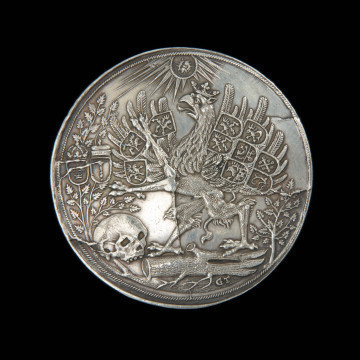
The thaler on the occasion of the solemn funeral of Prince Bogusław XIV
1654
National Museum in Szczecin
Part of the collection: Pomeranian coins
Duke Philip Julius of Wolgast began his independent minting activity in 1609, in an illegal mint in the Ducal Castle of Franzburg. Until 1615, the mint was in the hands of a tenant Casper Rottermund, who disregarded the Duke's orders and minted small coins of inferior purity and weight. Mass production of mainly low-value pennies and two-shilling coins contributed to monetary destabilisation and the outbreak of inflation, which developed into hyperinflation. At the beginning of the 1720s, the crisis covered the whole Reich, and it was the period called Kipper und Wipperzeit. Due to the poor quality of money, the Duke's efforts to legalise the mint did not have the expected result, although the county states tolerated numerous mints, apart from the statutory ones, as long as their issues were up to standard. Despite calls from the states to close the mint, the Duke continued to operate it until the end of his reign. The repair of coinage was an urgent political demand. The most visible result of the Duke's struggle against inflation was the abandonment of minting and the devaluation of the low-value two-shillings. Following the example of Lübeck, Hamburg and Lüneburg, Spanish reales and pesos, minted from good South American silver, were taken out of circulation and made for a new series of 1/16 thalers called düttchen, in 1622. These scarce coins were given their original wording on the reverse (Nach Alten Schrott und Korn), which figuratively manifested a return to complete coinage, like good grain. This reference had a psychological meaning, indicating the strength and tradition of the Reich. On the iconographic side, the most prominent is the griffin in a shield placed on a long cross, which propagated the symbolic presence of the Duke. The signature of the acorn refers to the mint master Hans Puls, who held this position between 1622 and 1625.
Genowefa Horoszko
Other names
1/16 Taler|Düttchen
Author / creator
Dimensions
cały obiekt: height: 1.2 mm, diameter: 28.6 mm
Object type
coin
Technique
minting
Material
silver
Creation time / dating
Creation / finding place
Owner
National Museum in Szczecin
Identification number
Location / status

1654
National Museum in Szczecin

1654
National Museum in Szczecin

1654
National Museum in Szczecin
DISCOVER this TOPIC
Museum of King Jan III's Palace at Wilanów
DISCOVER this PATH
Educational path